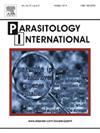A phylogeographic approach of three species of Clinostomum Leidy, 1856, (Trematoda: Clinostomidae) from the Neotropical region of Mexico, with the description of a new species from Ardea herodias (Ardeidae)
IF 1.9
4区 医学
Q3 PARASITOLOGY
引用次数: 0
Abstract
Clinostomum Leidy, 1856 is a globally distributed group of endoparasites that reside attached to the mucosa of the mouth cavity and oesophagus of fish-eating birds (mainly herons) in the adult stage, whereas larvae known as metacercariae (“yellow grubs”) damage freshwater fish and amphibians that serve as secondary intermediate hosts. In the Nearctic and Neotropical regions of Mexico, species of the genus Clinostomum have been intensively studied, revealing seven species that share a common ancestor. In the present study, sequences of the ITS from nuclear ribosomal DNA and cox 1 from mitochondrial DNA were generated for C. tataxumui, C. cichlidorum, and an unidentified species identified as lineage 3 sensu Pérez-Ponce de León et al. 2026, which is distributed sympatrically in Mexico and Middle America. The objectives of the present study were to 1) describe a new species of Clinostomum, named herein as Clinostomum chaacci n. sp., which combines morphological and molecular characters; 2) analyse the population genetic structure of two previously described species in addition to C. chaacci n. sp.; and 3) infer phylogeographic patterns using cox 1 sequences. The inferred phylogeographic results indicated that the populations of C. tataxumui, and C. cichlidorum lack a geographic structure with high haplotype diversity, low nucleotide diversity, and low Fst values among the populations with negative values on the neutrality test, suggesting that the populations are expanding. In contrast, the populations of C. chaacci n. sp., are less connected and subdivided into smaller populations, leading to slight genetic differentiation, suggesting that the populations have undergone significant demographic changes, such as recent expansion or selection effects.

A phylogeographic approach of three species of Clinostomum Leidy, 1856, (Trematoda: Clinostomidae) from the Neotropical region of Mexico, with the description of a new species from Ardea herodias (Ardeidae).
Clinostomum Leidy, 1856是一种分布于全球的内寄生虫,在成虫阶段附着在食鱼鸟类(主要是苍鹭)的口腔粘膜和食道上,而被称为metacercariae(“黄蛴螬”)的幼虫则损害作为次级中间宿主的淡水鱼和两栖动物。在墨西哥的新北极和新热带地区,人们对Clinostomum属的物种进行了深入研究,发现有7种物种拥有共同的祖先。本研究对分布于墨西哥和中美洲的C. tataxumui、C. cichlidorum和一种被鉴定为谱系3 sensu p - ponce de León et al. 2026的未识别物种进行了核糖体DNA ITS序列和线粒体DNA cox 1序列的合成。本研究的目的是:1)描述一种具有形态特征和分子特征的Clinostomum chaacci n. sp.;2)分析了上述两种昆虫的种群遗传结构以及chaacci n. sp.;3)利用cox推断系统地理模式。推断的系统地理结果表明,在中性检验为负值的种群中,柽柳和雪杉种群缺乏高单倍型多样性、低核苷酸多样性和低Fst值的地理结构,表明种群正在扩大。相比之下,chaacci n. sp.种群间的联系较少,并被细分为较小的种群,导致了轻微的遗传分化,这表明种群经历了重大的人口统计学变化,例如最近的扩张或选择效应。
本文章由计算机程序翻译,如有差异,请以英文原文为准。
求助全文
约1分钟内获得全文
求助全文
来源期刊

Parasitology International
医学-寄生虫学
CiteScore
4.00
自引率
10.50%
发文量
140
审稿时长
61 days
期刊介绍:
Parasitology International provides a medium for rapid, carefully reviewed publications in the field of human and animal parasitology. Original papers, rapid communications, and original case reports from all geographical areas and covering all parasitological disciplines, including structure, immunology, cell biology, biochemistry, molecular biology, and systematics, may be submitted. Reviews on recent developments are invited regularly, but suggestions in this respect are welcome. Letters to the Editor commenting on any aspect of the Journal are also welcome.
 求助内容:
求助内容: 应助结果提醒方式:
应助结果提醒方式:


